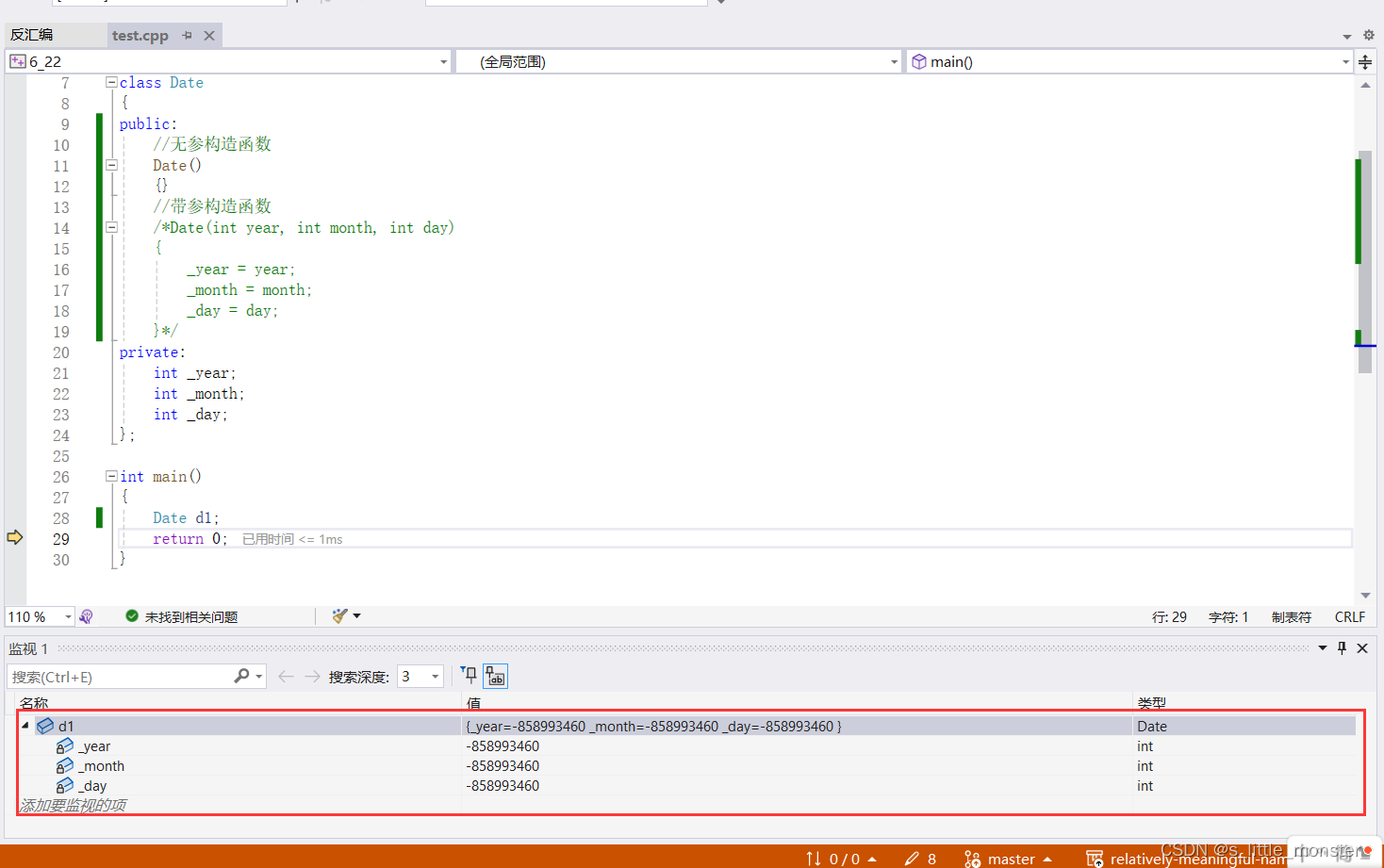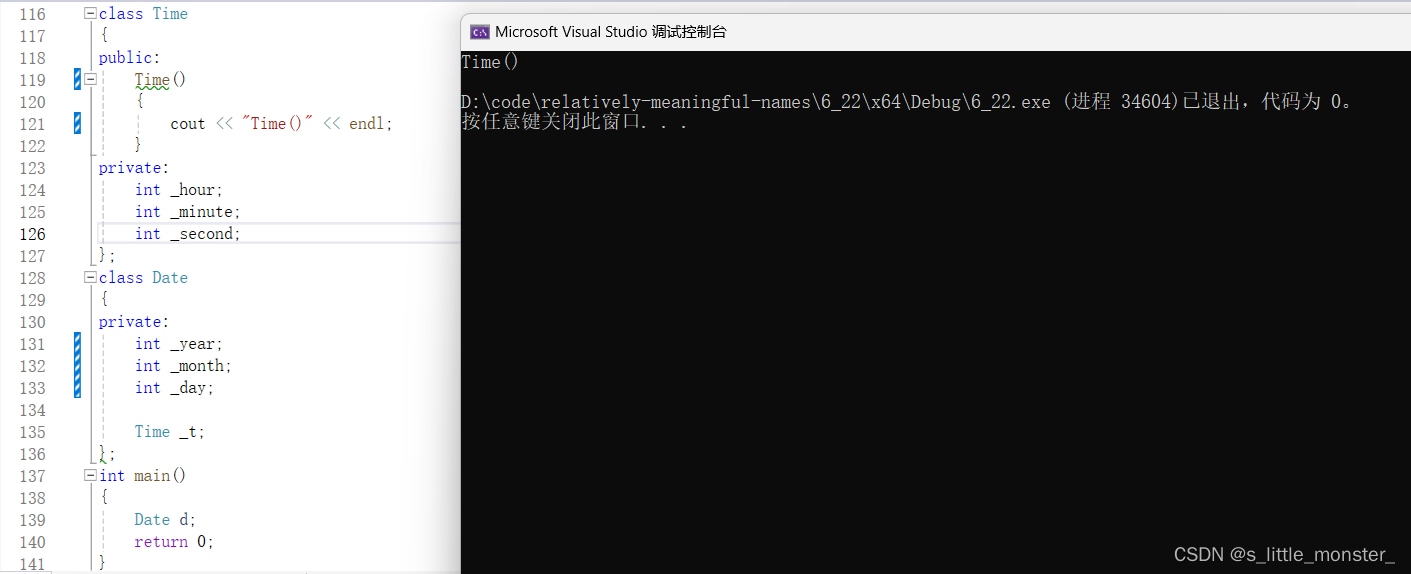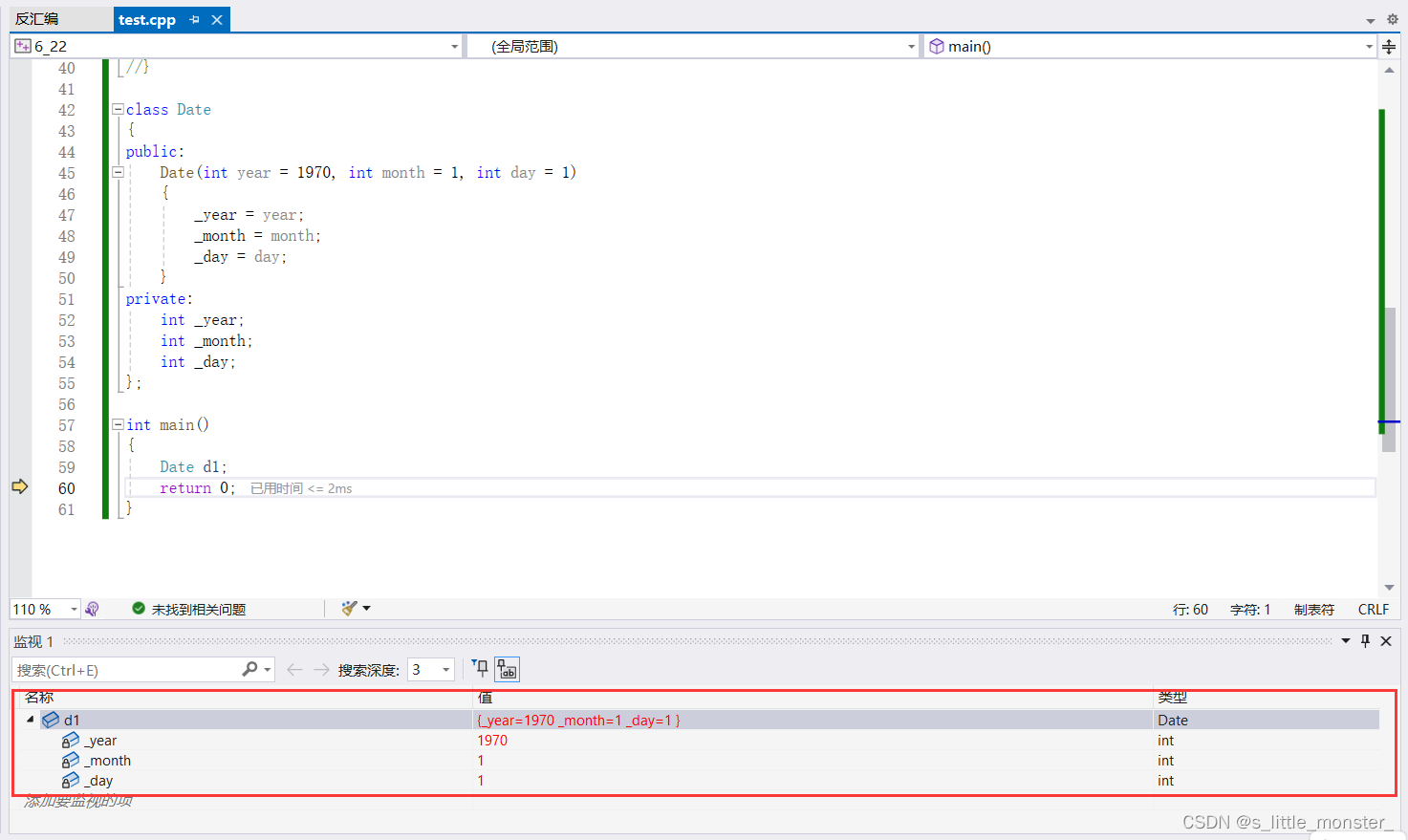一、类的六个默认成员函数
如果有个类中什么成员都没有,那么被称为空类
由编译器自动生成的成员函数称为默认成员函数
空类中会自动生成六个默认成员函数,这六个默认成员函数在每个类中都会自动生成
①初始化功能的构造函数
②清理功能的析构函数
③使用同类对象初始化创建对象的拷贝构造
④把一个对象赋值给另一个对象的赋值重载
⑤对普通对象取地址重载
⑥对const对象取地址重载
这六个默认成员函数主要将操作对象分为内置类型和自定义类型,对二者有不同的操作
二、构造函数
1、构造函数基本概念
构造函数是一个特殊的成员函数,名字与类名相同,创建类类型对象时由编译器自动调用,以保证每个成员都要初始化,并且在对象整个生命周期内只调用一次
2、构造函数的特性
构造函数是特殊的成员函数,主要任务就是初始化对象
(1)函数名与类名相同
(2)无返回值
(3)对象实例化时编译器自动调用
(4)可以重载
class Date
{
public:
//无参构造函数
Date()
{}
//带参构造函数
Date(int year, int month, int day)
{
_year = year;
_month = month;
_day = day;
}
private:
int _year;
int _month;
int _day;
};
无参调用不用加括号:
//无参调用
Date d1;
//有参调用
Date d2(2024,6,22);
(5)如果类中没有显式定义构造函数,则编译器会自动生成一个无参的默认构造函数,如果有显式定义,编译器将不再生成
class Date
{
public:
//无参构造函数
Date()
{}
private:
int _year;
int _month;
int _day;
};
由编译器自己生成:
编译器会自动生成一个无参的默认构造函数,初始化给的是随机值
(6)行文至此有人会觉得编译器给的无参的默认构造函数很垃圾,初始化给的是随机值,没有什么意义,他对于自定义类型来说是有很大的意义的,它可以调用自定义类型的默认构造函数
class Time
{
public:
Time()
{
cout << "Time()" << endl;
}
private:
int _hour;
int _minute;
int _second;
};
class Date
{
private:
int _year;
int _month;
int _day;
Time _t;
};
int main()
{
Date d;
return 0;
}
内置成员变量在类中声明时可以给默认值
class Date
{
private:
int _year = 1970;
int _month = 1;
int _day = 1;
};
int main()
{
Date d;
return 0;
}
(7)无参的构造函数、全缺省的构造函数、不写而编译器自动生成的构造函数都叫默认构造函数
全缺省:
class Date
{
public:
Date(int year = 1970, int month = 1, int day = 1)
{
_year = year;
_month = month;
_day = day;
}
private:
int _year;
int _month;
int _day;
};
int main()
{
Date d;
return 0;
}
三、析构函数
1、析构函数的概念
析构函数是与构造函数功能相反的一个函数,对象在销毁时会自动调用析构函数,完成资源清理
2、特性
(1)析构函数名是在类名前加上字符~
(2)无参数无返回类型
(3)一个类只能有一个析构函数,未显式定义则自动生成
(4)生命周期结束时自动调用
构造函数+析构函数改造栈:
class Stack
{
public://公共访问,但在类中可以访问private的内容,只是在类外不能直接访问
Stack(size_t newcapacity = 4)//缺省
{
int* tmp = (int*)realloc(a, sizeof(int) * newcapacity);
if (tmp == nullptr)
{
perror("realloc fail");
exit(-1);
}
a = tmp;
capacity = newcapacity;
top = 0;
}
void Push(int x)
{
a[top++] = x;
}
void Pop()
{
top--;
}
int Top()
{
return a[top - 1];
}
bool Empty()
{
return top == 0;
}
~Stack()
{
free(a);
a = nullptr;
capacity = top = 0;
}
//自己写的析构函数,在程序执行的最后执行
private://隐私访问
int* a;
int top;
int capacity;
};
编译器自动生成的析构函数不能对内置类型进行资源回收,但可以调用自定义类型的析构函数
class Time
{
public:
~Time()
{
cout << "~Time()" << endl;
}//Time的析构函数
private:
int _hour;
int _minute;
int _second;
};
class Date
{
private:
int _year = 1970;
int _month = 1;
int _day = 1;
Time _t;
};
int main()
{
Date d;
return 0;
}
因为d中包含着四个成员变量,除了_year _month _day 外还有一个Time类,内置类型成员在销毁时不被资源清理,但自定义类型需要调用析构函数回收,但是main函数中不能直接调用Time类的析构函数,实际要释放的是Date类对象,所以编译器会调用Date类的析构函数,编译器默认生成析构函数的可以对自定义成员Time调用它的析构函数,即当Date销毁时,Time也会销毁
如果类中没有申请资源时,也就是没有在堆上申请空间时,析构函数可以不写,直接使用编译器生成的默认析构函数,有申请资源的话一定要写,防止资源泄露
四、拷贝构造函数
1、拷贝构造函数的概念
只有单个形参,该形参是对本类类型对象的引用(一般用const修饰),在用已存在的类类型对象创建对象时,由编译器自动调用
2、特征
(1)拷贝构造函数是构造函数的一个重载形式
(2)拷贝构造函数的参数只有一个且必须是类类型对象的引用,使用传值方式编译器直接报错,原因是会引发无穷递归调用
传引用调用:
class Date
{
public:
Date(int year = 1970, int month = 1, int day = 1)
{
_year = year;
_month = month;
_day = day;
}
Date(const Date& d)
//函数名与析构函数一样,都是类名,所以拷贝构造函数是构造函数的一个重载形式
{
_year = d._year;
_month = d._month;
_day = d._day;
}
private:
int _year;
int _month;
int _day;
};
int main()
{
Date d1;
Date d2(d1);
return 0;
}
传值调用:
我们知道传值调用形参会开辟一块空间,成为实参的临时拷贝,这样会创建一个Date,因为类会自动调用里面的六个默认成员函数,拷贝构造函数也是其中之一,这样一来,又会创建一个Date,以此类推,无限循环
(3)若未显式定义,编译器会生成默认的拷贝构造函数,这个默认的拷贝构造函数是值拷贝
在编译器生成的默认拷贝函数中,内置类型是按照字节方式直接拷贝的,而自定义类型是调用其拷贝构造函数完成拷贝的
class Time
{
public:
Time()
{
_hour = 1;
_minute = 1;
_second = 1;
}
Time(const Time& t)
{
_hour = t._hour;
_minute = t._minute;
_second = t._second;
cout << "Time(const Time & t)" << endl;
}
private:
int _hour;
int _minute;
int _second;
};
class Date
{
public:
Date(int year = 1970, int month = 1, int day = 1)
{
_year = year;
_month = month;
_day = day;
}
private:
int _year;
int _month;
int _day;
Time t;
};
int main()
{
Date d1;
Date d2(d1);//这里是用已有的d1拷贝构造d2
return 0;
}
(4)编译器默认生成的拷贝构造函数可以拷贝像Date类这样的类,但对于某些类来说我们要显式定义
class Stack
{
public:
Stack(size_t newcapacity = 4)
{
int* tmp = (int*)realloc(a, sizeof(int) * newcapacity);
if (tmp == nullptr)
{
perror("realloc fail");
exit(-1);
}
a = tmp;
capacity = newcapacity;
top = 0;
}
void Push(int x)
{
a[top++] = x;
}
void Pop()
{
top--;
}
int Top()
{
return a[top - 1];
}
bool Empty()
{
return top == 0;
}
~Stack()
{
free(a);
a = nullptr;
capacity = top = 0;
}
private:
int* a;
int top;
int capacity;
};
int main()
{
Stack s1;
s1.Push(1);
s1.Push(2);
Stack s2(s1);
return 0;
}
该程序中没有显式定义拷贝构造函数吗,是调用的编译器自动生成的拷贝构造函数
在执行析构函数的时候出现了错误,这里的原因是数组a已经被释放了,再次释放产生错误
因为编译器自动生成的拷贝构造函数是值拷贝,所以在生成s2时,s2中的指针a指向的数组与s1中的指针指向的数组相同,在程序结束时,调用析构函数释放了s2,对应的这块数组空间也被释放,然后调用析构函数释放s1,已经被释放的空间不能被再次释放,所以出现了这样的错误,所以我们需要自己显式定义一个拷贝构造函数
深拷贝:
Stack(const Stack& s)
{
cout << "Stack(const Stack& s)" << endl;
int* a = (int*)malloc(sizeof(int) * capacity);
if (a == nullptr)
{
perror("malloc fail");
exit(-1);
}
memcpy(a, s.a, sizeof(int) * s.top);
top = s.top;
capacity = s.capacity;
}
(5)拷贝构造函数的使用场景:
已存在的对象建立新对象
函数参数为类类型对象
函数返回值为类类型对象
class Date
{
public:
Date(int year, int month, int day)
{
cout << "Date(int,int,int):" << this << endl;
}
Date(const Date & d)
{
cout << "Date(const Date& d):" << this << endl;
}
~Date()
{
cout << "~Date():" << this << endl;
}
private:
int _year;
int _month;
int _day;
};
Date Test(Date d)
{
Date temp(d);
return temp;
}
int main()
{
Date d1(2022, 1, 13);
Test(d1);
return 0;
}
因为我所使用的编译器为VS2022,是一种新的编译器,会对程序有一定的优化
我们来分析一下,如果编译器不优化,打印出的结果是什么
①创建d1类,调用构造函数,打印"Date(int,int,int):"和d1的地址
②以d1拷贝构造形参d,调用拷贝构造函数,打印"Date(const Date& d):"和d的地址
③以d拷贝构造形参temp,调用拷贝构造函数,打印"Date(const Date& d):"和temp的地址(这一步在编译器中被优化)
④返回temp时,会拷贝一份构造临时对象返回,调用拷贝构造函数,打印"Date(const Date& d):"和临时对象的地址
⑤依次调用递归函数销毁temp(这一步在编译器中被优化),d,临时对象,d1
传参时,能够进行引用传参的尽量使用引用传参,因为引用传参不需要再拷贝占用空间,提高程序运行效率
今日分享结束~














